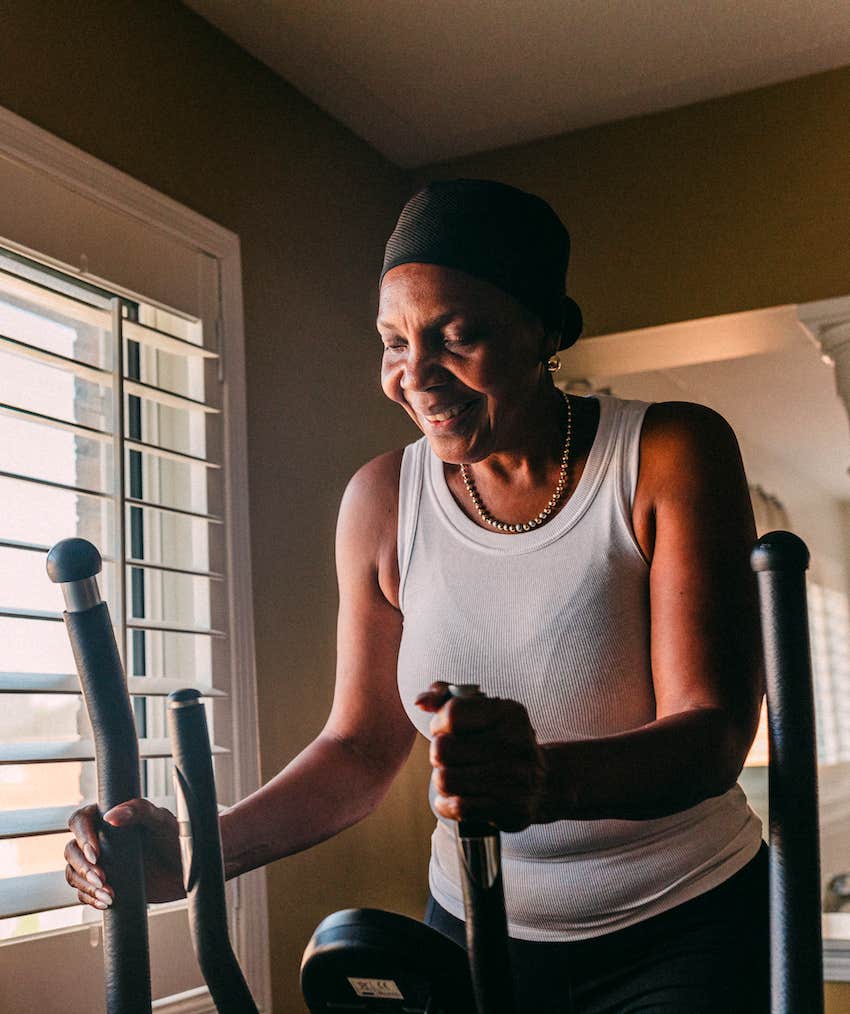What It Means If You Cry During A Hard Workout
A certified fitness instructor shares the spiritual and scientific reasons why.
 MART PRODUCTION | Canva
MART PRODUCTION | Canva There's a popular TikTok where a young man cries after a run, asking viewers what is wrong with him. Many replied that it happens to them, too, and at least one replied they avoid the gym because they can't control the tears. Several responded that they understood it as an emotional release and mentioned somatic and bilateral movement.
They are right, and there is nothing 'wrong' with him, them, or you if you cry after a great workout. It's a common occurrence that has everything to do with the mind-body connection.
Here's why so many people cry during a hard workout.
As a new fitness instructor, I was super excited to get hired by one of the most popular gyms in my city. I recall being nervous preparing, hoping to make a good first impression. Members packed the room, and my energy was high as I began that first dance fitness group. My nerves eased once the music started, and I was relieved to notice the participants smiling and enjoying themselves.
Then, near the end of the lesson, I saw her. A woman in the third row was crying! It almost derailed me, as my first thought was she must miss the instructor I replaced, but I kept going and finished the lesson.
I wanted to approach her to ask if she was okay, but she came to me before I could. To my surprise, she said she felt amazing and wanted to know the title and artist of the final song. Whew! I felt relieved, and a tear ran down my cheek — or was it a bead of sweat? Regardless, she was not only okay, she was great!
I had completely misread her tears. She apologized and said she didn't know why she was crying. We both laughed, and I know now what I didn't know then. It's called somatic release. By the way, the final song was Indie Arie's Acoustic Beautiful.
1. Tears are the mind-body connection at work
Since those early days in the gym, I've studied the mind-body connection from a fitness instructor's perspective and as a professional life coach. This has helped me help my clients from a greater holistic perspective, understanding the connection and how it helps us heal.
Our mind holds our thoughts, memories, and images of and about our experiences, and these create our emotions. We can feel our emotions in our bodies like when we are excited to see someone we love and get butterflies in our stomachs, or our cheeks flush red with a warm sensation when shyness overcomes us as we are flattered by someone.
When we haven't dealt with our challenging and negative emotional 'stuff' — when we have repressed and kept it inside — it is believed these emotions (energy in motion) can get trapped in our bodies and become sources of pain and even disease. The tear ducts are a great escape route!
![]()
Photo: spixel via Shutterstock
2. Exercise triggers somatic release.
So, crying while exercising can result from a painful experience that has not been fully healed even though we have moved on. It's called somatic (of the body) release, and the bilateral or alternating, rhythmic movement of running, dance, tai chi, yoga, and other forms of exercise can trigger it.
Perhaps heartbreak, even though we don't consciously think about it, still lingers as anxiety and a tightening in the chest, or the hurtful words our mother spoke to us as a child are buried deep and irritate our gut, or the fear from the junior high bullying experience has left our hips painfully tight as if we are still frozen and unable to take a step to fight back or run from the threat.
3. Crying feels good and heals.
Regardless of the reason we may have suppressed emotion or been unable to express it, it will adversely affect us until it is released and healed. Holding in our emotions has been linked to many health issues like heart disease, stress disorders, anxiety, depression, a compromised immune system, and some cancers.
The author of this Harvard Health Publication Blog explains that the ancient Greeks and Romans recognized crying as a way of purging and purifying us and that modern-day psychologists explain crying as a means to release stress and emotional pain as it releases the feel-good hormones oxytocin and endorphins. I know I always feel better after a blubbering cry, do you?

Photo: Alice Xue Photography via Shutterstock
Exercise of any kind when you are not thinking about the result, counting reps, noting how much you can lift, how far you can go, what you look like, some would say when you are out of "ego" — you are just doing it, allowing your body to move — like running, spinning, dancing, pilates, yoga, tai chi, etc., can lead to an unconscious freeing of the entrapped emotion.
This act of emoting often surprises the person, as it did the woman from the third row in my dance group. If you feel the tears coming while you are working out, let them flow. It's a sign your mind and body are working together to help you heal. Don't resist it. It is beautiful.
Ann Papayoti, PCC, is a relationship coach, author, speaker, and host of the podcast Soul CPR Healing Out Loud. She helps people untangle from their past, heal from heartbreak, and revive their lives.
